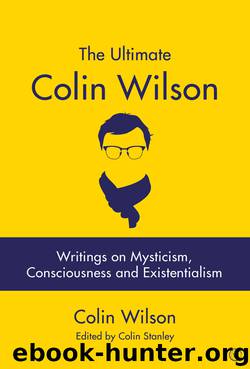The Ultimate Colin Wilson by Colin Stanley

Author:Colin Stanley
Language: eng
Format: epub
Publisher: Watkins Media
THE LAUREL AND HARDY THEORY OF CONSCIOUSNESS
From the magazine Second Look (October 1979)
A couple of months ago, I found myself involved in the re-writing of a film script about that legendary hero Flash Gordon. In one of the scenes, Flash’s old friend and ally, Professor Zarkov, is being held prisoner by the secret police of Ming the Merciless, who proceed to brain-wash him with a machine that is intended to turn him into a loyal servant of Ming. But ten minutes further on in the movie, Zarkov has to reveal that the brainwashing was unsuccessful. The reason given by the previous script writer was unconvincing, not to say absurd. I decided on something that sounds at least more technically convincing. The human brain has two halves that are almost identical, and the question of why this should be so is still unsolved by the science of brain physiology. We have, it seems, two separate memory systems, and to some extent, each half of the brain stores the same information. If Ming’s secret police happened to be unaware of this because the inhabitants of the planet Mongo have ‘single’ brains — then they might well leave one of Zarkov’s memory systems intact….
Which left me with an interesting question, to which I have since devoted some thought. What would a single brained being be like? How would he differ from us? Why, in fact, do we have two brains?
Since I am not a brain physiologist, or even a scientist, any answers I have to suggest will be by way of pure speculation. Still, even mistaken theories can be useful. One of the most stimulating books I have read in recent years is The Origin of Consciousness in the Breakdown of the Bicameral Mind, by Julian Jaynes, in which he seriously suggests that our ancestors of a couple of thousand years B.C. lacked any kind of self-awareness — any sense of themselves as individual egos. I am certain that he is wrong; yet I’ve had more fun trying to work out why than in reading any number of more cautious and sober works of psychology. If my own suggestions can provide anything like the same stimulation, then the sufferings of Professor Zarkov will not have been in vain.
Let me begin by sketching the known facts. More than a century ago, the neurologist Hughlings Jackson noted that the left cerebral hemisphere seems to be concerned with expression — speech — while the right deals with recognition. The cerebral hemispheres — the top part of the brain — are the most specifically human part of us — our thinking apparatus. These hemispheres consist of two mirror-like halves, joined by a bridge called the commissure, the corpus callosum. But the purpose of this bridge is still obscure — Karl Lashley made the tongue-in-cheek suggestion that it was to stop the two halves of the brain from sagging. When the commissure is severed, as it sometimes is to prevent epileptic seizures, there is no obvious difference in the patient’s behaviour.
Download
This site does not store any files on its server. We only index and link to content provided by other sites. Please contact the content providers to delete copyright contents if any and email us, we'll remove relevant links or contents immediately.
| Ancient & Controversial Knowledge | Ghosts & Hauntings |
| Hermetism & Rosicrucianism | Magic Studies |
| Occultism | Parapsychology |
| Supernatural | UFOs |
| Unexplained Mysteries |
Animal Frequency by Melissa Alvarez(4364)
Sigil Witchery by Laura Tempest Zakroff(4147)
Real Magic by Dean Radin PhD(4045)
Fingerprints of the Gods by Graham Hancock(3888)
Journeys Out of the Body by Robert Monroe(3537)
Aleister Crowley: The Biography by Tobias Churton(3530)
The Rosicrucians by Christopher McIntosh(3439)
Alchemy and Alchemists by C. J. S. Thompson(3421)
Mysteries by Colin Wilson(3361)
Hitler's Monsters by Eric Kurlander(3240)
The Hatha Yoga Pradipika (Translated) by Svatmarama(3178)
John Dee and the Empire of Angels by Jason Louv(3107)
Wicca: a guide for the solitary practitioner by Scott Cunningham(3102)
Infinite Energy Technologies by Finley Eversole(2892)
Book of Life by Deborah Harkness(2830)
Dark Star Rising by Gary Lachman(2800)
The Book of Lies by Aleister Crowley(2777)
Aliens by Jim Al-Khalili(2760)
To Light a Sacred Flame by Silver RavenWolf(2737)
